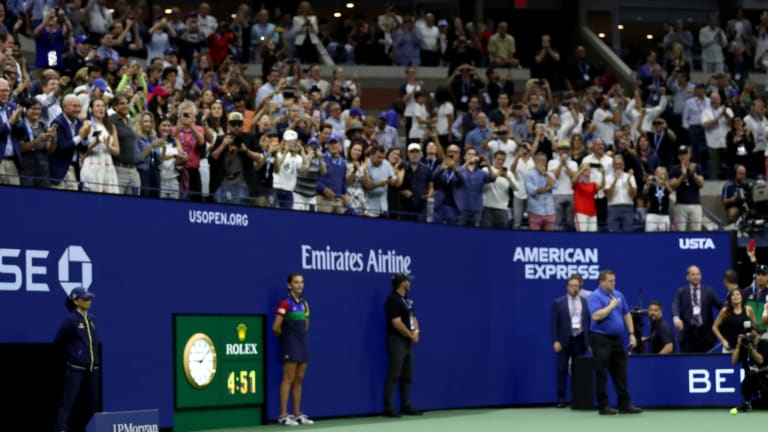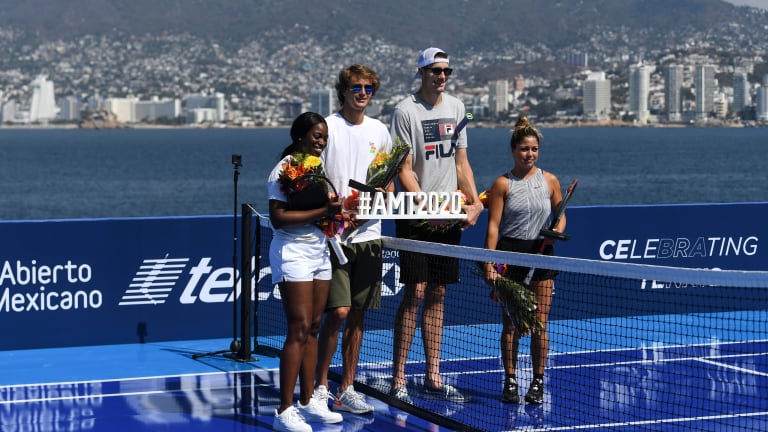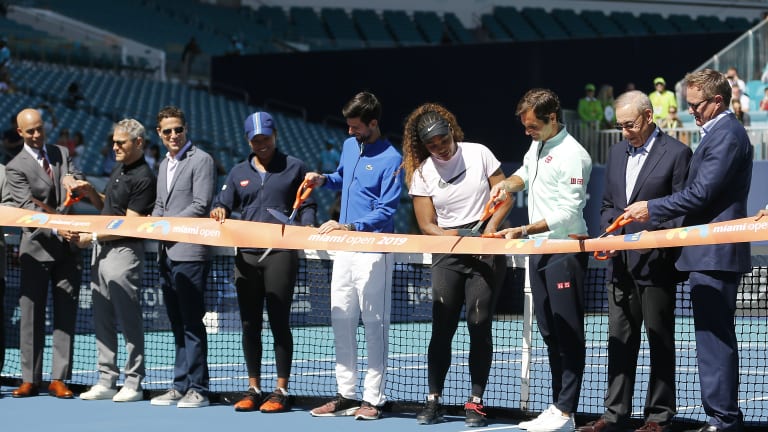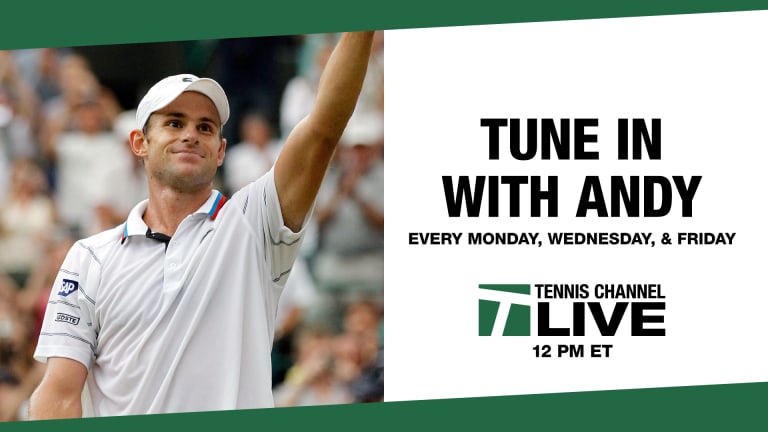The Rally: Without a commissioner, will tennis reform while on hiatus?
Apr 13, 2020ATP cancels China swing, including Shanghai Masters, and adds six 250 events to 2022 calendar
By TENNIS.com Jul 21, 2022Pandemic surge hits Australian Open: Bernard Tomic's COVID-19 prediction comes true, spectators capped at 50 percent
By Kamakshi Tandon Jan 13, 2022Novak Djokovic has been exempted—but his stance hasn’t been vindicated
By Steve Tignor Jan 04, 2022Rafael Nadal back on track for Australian Open following COVID-19 case
By Kamakshi Tandon Dec 30, 2021Aussie Open field starts to experience effects of pandemic surge, vaccination issues
By Kamakshi Tandon Dec 21, 2021"It will happen this year": Stefanos Tsitsipas planning to get COVID-19 vaccine
By Kamakshi Tandon Sep 21, 2021Going to the US Open? Proof of vaccination status now required after change in COVID-19 policies
By TENNIS.com Aug 27, 2021A vaccinated Sofia Kenin to miss 2021 US Open due to positive COVID-19 test
By Matt Fitzgerald Aug 26, 2021The Rally: if you wanna play a major, you must play by the local rules
Jan 18, 2021The Rally: Without a commissioner, will tennis reform while on hiatus?
From finding ways to create a better safety net for more players and reviewing the calendar, to no longer seeing our sport's athletes as interchangeable entities, an extended hiatus might allow the sport to make a drastic, yet necessary overhaul.
Published Apr 13, 2020
Advertising
In this week’s Rally, Joel Drucker and Steve Tignor talk about the chances for a 2020 tennis season, and how the game might change once the coronavirus crisis has passed. Connect with Steve and Joel on Twitter by using the hashtag #MondayRally.
Joel,
Instead of daily scores and results, these days sports fans are inundated with desperate plans to salvage seasons. The NBA has some of its stars playing HORSE. Major League Baseball is considering holding all of its games in empty stadiums in Arizona and Florida, each state a host for Spring Training, and each with an abundance of stadiums in close proximity. The NHL might try to do the same in North Dakota, New Hampshire or Saskatchewan.
I understand the desire. We could all use a little sports in our lives right now, and you only have to see a photo of 10,000 cars lined up at a food bank in San Antonio to understand the gravity of this economic shutdown. That goes for double for tennis players, most of whom only make money when they win matches, and almost all of whom are currently stuck at home. To me, though, these ideas about reopening sporting leagues come across as either far-fetched or hardly worth the effort, a grim way to conclude a grim year.
This week it was new ATP CEO Andrea Gaudenzi’s turn to sketch out a plan for men’s tennis. To be specific, he said the game is weighing 50 different variations on a condensed and turbo-charged 2020. The general idea is that it would begin in late July with the North American summer hard-court season, which concludes with the US Open. After that, a clay season would be played in September, then the Asian swing, and the men would conclude with the ATP Finals in its final year in London, on its scheduled dates.
“If that were to happen,” Gaudenzi said, “it would mean that we rescued 80 percent of the season, other than cancelling the grass events. With seven Masters 1000s and three Slams, there wouldn’t be much room for complaints.”
I’ll start by saying that Gaudenzi seems like a good man for this job, and it’s unfortunate that his first task will be to try to rescue the ATP from perhaps the worst crisis to ever hit the sporting world. He’s a former player—with wins over Federer and Sampras—and a business executive with a law degree and an MBA. Theoretically, everyone on the men’s side should be comfortable with him, which could make a difference in trying to pull something like this off.

The Rally: Without a commissioner, will tennis reform while on hiatus?
© Getty Images
Advertising
Getty Images
The schedule sounds great when you imagine it. Hard courts straight into clay straight into indoor, and all wrapped up in five months, with none of the lulls that normally bloat the season to a full year. If it’s a success, maybe the ATP will realize it really can shorten its calendar and not lose all that much. But there’s obviously a long way to go before any of Gaudenzi’s ideas become reality, and his plan was dealt an immediate blow on Saturday when the WTA Rogers Cup, in Montreal—the first big event in the North American circuit—was canceled.
The linchpin, Gaudenzi says, is that the US Open needs to be played on time. You’ve surely seen the photos, Joel, of what’s happening at Flushing Meadows right now: It’s being turned into a temporary hospital. Some might say we can play the Open with no fans, but what happens if there’s a positive coronavirus test among the players or on-court officials? It took just one for the NBA to rightly shut its season down. Having endured this crisis at its epicenter, in New York and New Jersey, and seen its devastation firsthand, I don’t think sports should come back until they’re 100 percent safe for everyone to play and watch.
Also, when do we play the French Open?
Does tennis this season seem possible to you, Joel? If so, how would you like to see it play out?
Steve,
One of our readers contacted me this week and we ended up exchanging notes on music. He said one of his favorite bands was The Doobie Brothers, which made me recall one of that group’s songs that’s quite appropriate these days: “Minute By Minute.”
I have no idea if there will be tennis this year. Tennis on any terms will be worth it. Gee, maybe, as UFC explored, there can be an exhibition, played on an island, certainly with players fetching their own towels and maybe even calling their own lines.
It was fascinating to hear Gaudenzi citing 50 scenarios. Fifty? 50? It would be amazing to see at least ten of them in rich detail. North America first? Asia? Europe in the fall—outdoor clay, then indoors? Pro tennis in December? Fancy that, Christmas tennis.
Perhaps, with so many tournaments, the quest for ranking points and prize money will be a freewheeling land grab, offering opportunities for more players than ever. Consider, for example, that Roland Garros hopes to take place from September 20 to October 4. During that same fortnight, the current ATP Tour calendar lists six events on three continents, including the Laver Cup. Who plays where? And how does ATP Tour leadership feel about Roland Garros opting for those dates? September 21 is supposed to be the starting date for the St. Petersburg Open. Grand Slam draws usually accommodate the top 105 players in the world (filling the additional slots with wild cards and qualifiers). Does this mean that Evgeny Donskoy, currently ranked No. 115 in the world, becomes one of the top seeds in St. Petersburg?
As I ponder Gaudenzi’s comments, I’m keen to hear more from about the macro vision of how tennis will emerge from this global crisis. Our colleague Chris Clarey of the New York Timesrecently wrote a very interesting story about a great many events are financially threatened by recent events.

The Rally: Without a commissioner, will tennis reform while on hiatus?
© AFP via Getty Images
Advertising
Getty Images
So will there be renewed talk of calendar reform? Will this bring the ATP and the WTA closer together, or further apart? And what of the ITF, be it with the four majors—each of whom remains quite self-contained—as well as Davis Cup and Fed Cup? Amid so many concerns about travel, might there be more regionalized pro tennis?
And recently, for the first time ever, I’ve come to vividly see the challenge tennis players face. Team sports players are staff members, hired by an organization and given a salary. Alas, tennis players are gig workers, operating in work-for-hire mode. I’m curious to see how this is addressed. For that matter, should it be addressed? One wonders what the raw and rugged economic shakeout of pro tennis will look like 18 months from now.
I’m also curious to see what kind of talks tennis’ many powers—tours, nations, agents—are having about how to create an even more dynamic, overt leadership culture. From time to time, there have been theoretical discussions about the need for a commissioner of tennis. Heck, I wrote an article about this more than 20 years ago and at times have argued that it should be more of a populist, citizen’s watchdog-like organization than an instrument of power. But so long as players continued to make more money and the calendar continued to be heavy with events, the idea remained more of an abstraction.
Steve, do you think the time has come for tennis to create a commissioner’s office? Is that even viable? And if so, what might it look like to you?
Joel,
I’m not sure if anyone is against the idea of a tennis commissioner. It would, at the very least, be the simplest way to unify a disunited sport. But maybe there’s a reason why it hasn’t happened. It would take a very special politician and personality to keep the peace between the ATP, WTA, ITF and the Grand Slams, who together function more like rival companies than partners in the same business. Can you imagine a “Commissioner of Basketball,” who would have authority over not just the NBA, but every professional basketball league around the world? That’s essentially what we’re talking about when we talk about a commissioner of tennis. Is that job feasible?
Still, in every walk of life right now, the coronavirus crisis has engendered talk of sweeping change. Will we stop working in offices and shopping at retail stores? Is this the end of public transportation? Will Americans demand universal health insurance? Will young people take up careers in mask design? By the fall, we may have forgotten about many of these ideas, and settled back into the status quo—inertia is the most powerful force of all. But for now we can dream.
What changes would you make to tennis, Joel? It seems like a must that we look at finding ways to create a better safety net for more players, and to make pay more equitable. As far as the schedule goes, I guess I’m a glass-half-full, “if it’s ain’t broke, don’t fix it” type of person. If tennis didn’t change a thing, I wouldn’t complain. I like the long, winding, lull-filled, sometimes-confusing season, because it means that there’s always tennis happening somewhere. I don’t mind that the men play best-of-five and the women best-of-three at the Slams, even though there’s no logical reason for it. I like that it’s a niche sport rather than a mass sport—it feels like it’s mine and not the world's.

The Rally: Without a commissioner, will tennis reform while on hiatus?
© Getty Images
Advertising
Getty Images
At the same time, I also believe that tennis has made solid improvements during the time that I’ve been a fan. I think you’d agree that the tours, as they’re organized now, around the majors and a set number of mandatory tour events, make for a better, cleaner product than they did during the exhibition-filled wild west days of the 1980s, when everyone did their own thing. The advent of the men's Masters series, and the rise of dual-gender tour events, have made a bigger positive difference in the game than most people realize, and are proof that new ideas can work, even in tennis.
I would hate to see smaller tournaments disappear after this crisis, but if it were to happen, it could clear the way for a less cluttered calendar that revolves even more around the mandatory, dual-gender tournaments I just mentioned. It would be ideal to see a schedule that starts in March and ends in October, and keeps the men and women joined at the hip most of the way, from Australia through Indian Wells, Miami, Madrid, Rome, Paris, Canada, Cincy, the US Open, and then on to a team finale.
Like I said, we can dream, right?
Joel, are you a status-quo kind of guy, or a revolutionary?
Steve,
How interesting that you ask that question, as just this morning, I was reading several essays by one of my touchstone writers, George Orwell, a man often described as a “Tory anarchist”—that is, someone who valued many of his homeland’s traditions while concurrently making the case for reform. One great Orwell essay title: “My Country Right or Left.”
So that would be me with tennis: I cherish many of our sport’s traditions—but have studied them closely enough to know the ones I still like and which I believe compel change. For example, I despise on-court coaching, watch clips of matches from the ‘60s and ‘70s and can make a strong case for the link between ‘30s great Don Budge and Novak Djokovic. But I’m leaning towards playing two-out-of-three sets in the early rounds of men’s Grand Slam events. Nor do I care for all-white clothing at Wimbledon (or any other facility). I also think tennis at the Olympics should be played as a mixed team event along the lines of World TeamTennis and that it’s worth spending three to four years to see if the new Davis Cup format might work out.
Calendar-wise, I’ve long thought that the tennis year should start in Florida, head west to Indian Wells, then off to Australia in March. But as I’ve learned from disparate factions in a rather vociferous manner, each event has a territorial rationale for scheduling, ranging from weather to vacation times.
We in the United States talk about states’ rights. In tennis, this plays out globally. While everyone agrees about the need for change, few wish to give up their piece of the pie. Years ago, a Top 20 player complained to me about the quality of the men and women calling lines. When I asked if he’d be willing to give up two percent of his earnings to pay them more, he looked at me like I was asking him to rob a bank.

The Rally: Without a commissioner, will tennis reform while on hiatus?
© Getty Images
Advertising
Getty Images
Here’s a more simple reform. Whenever a player is on the grounds of a tournament—be it practice, sponsor parties, or playing matches—he or she should wear a shirt that has his or her name on the back of it. There’s no need to see these incredible athletes as interchangeable, faceless entities. And those players in turn should do much more—at all events—to engage with the public, be it with clinics, signings, interviews and more. It’s amazing how difficult this is to make happen even at lower-level events.
Even now, during this crisis, I’d like to see players do more to connect with their fans. These many social media posts we’re currently seeing are nice, but how about more players talking to their fans? Alison Riske spoke last week at a UTR webinar and it was quite engaging.
Throughout this current period and beyond, my hope is that far more players at all levels come to understand their role in making tennis thrive. Top-down commissioner’s office? With all this factionalism, it’s tough to see it having much leverage. So maybe instead, change can happen from the ground up. Given what our culture and economy is going to look like in this decade, being able to play tennis proficiently might well be only one piece in the puzzle.

The Rally: Without a commissioner, will tennis reform while on hiatus?